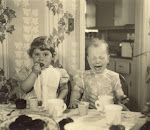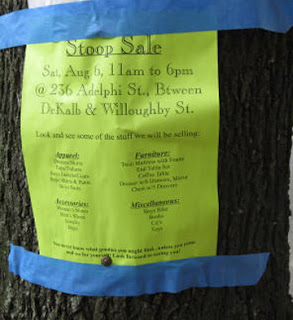271 Clermont where the Valentines lived in the early 1920s.
Stoop was a word with a negative connotation when I was a child. It was s-oo-o-o New York, so inner city.
I liked to sit on the front steps of our brand new ranch house in Kansas. I was often told it didn't look good to sit on the stoop. I should sit on the patio at the back of the house. There was, however, nothing happening at the back of the house (actually, there was very little happening at the front of the house either.)
Lower Manhattan when it was a Dutch colony.
I recently read a great book about the Dutch colonies in New York (The Island at the Center of the World by Russel Shorto) and gained an appreciation for Dutch words and concepts, among them cookie, boss and stoop, which comes from stoep, Dutch for steps.
Pictures of Brooklyn then and now reveal the importance of the stoop.
Adelphi St. in the early 20th century.
Late 19th-century stoop
Breuckelen today
Stoop Sale
I found this on the internet (so it HAS to be true)
"Stoops in New York were a fundamental social marker. Because the Commissioners' Plan of 1811 left no room for back alleys, houses typically had no rear entrances. This meant that both the people who lived in the house and the servants would have to enter from the front. To solve the dilemma of how to get both groups into the house without having them use the same door, New Yorkers settled on the steep front staircase, called a stoop (after the Dutch "stoep," or porch, that graced the front of most New Amsterdam houses). The door at the top of the stoop became the formal entrance to the house; a small door under the stoop was used by tradesmen and servants. -Inside the Apple: A Streetwise History of New York City by Michelle Nevius, James Nevius"
206 Adelphi where Wm. & Cecelia Valentine lived in 1912.
Two entrances.
My literary friend Carol mentioned that the social realism of playwrights like Clifford Odets created a lower-class link.
The set from the 1931 film Street Scene
Just as the family was getting out of Brooklyn, the stoop became a symbol of the place one was from and the place one did not want to talk about.
The set for Carrie Bradshaw's stoop in Sex and the City
Gentrification has restored the stoop.As has newer thinking about urban neighborhoods. From the Wikipedia
In her pivotal book The Death and Life of Great American Cities, Jane Jacobs includes the stoop as part of her model of the self-regulating urban street. By providing a constant human presence watching the street, institutions such as stoops prevent street crime, without intervention from authority figures. In addition, they motivate better street maintenance and beautification, by giving it social as well as utilitarian value.
















No comments:
Post a Comment